|
|
|
Sort Order |
|
|
|
Items / Page
|
|
|
|
|
|
|
| Srl | Item |
| 1 |
ID:
182661
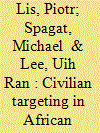

|
|
|
|
|
| Summary/Abstract |
Armed conflict actors frequently target civilian populations. Thus, an improved understanding of such behaviour could pave the way to reducing it. We use the Civilian Targeting Index (CTI) and a broad array of geo-referenced data to investigate the spatio-temporal and economic dynamics of civilian targeting by conflict actors in Africa. Two main insights are generated. First, the civilian targeting behaviour of African non-state conflict actors is strongly influenced by the behaviour of other proximate actors. In particular, non-state actors tend to increase their civilian targeting after nearby non-state actors have done so. Possible mechanisms to explain such spatial spillovers include emulation and retaliation. Second, a negative relationship between economic activity and civilian targeting exists and applies to both state and non-state actors. In addition, CTIs of non-state actors tend to increase with population density, the geographical spread of their conflict activity and conflict duration. State actors have higher average CTIs than non-state actors do, but the gap between the two actor types tends to close during long-duration conflicts.
|
|
|
|
|
|
|
|
|
|
|
|
|
|
|
|
| 2 |
ID:
173129
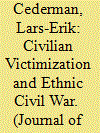

|
|
|
|
|
| Summary/Abstract |
While many studies provide insights into the causes of wartime civilian victimization, we know little about how the targeting of particular segments of the civilian population affects the onset and escalation of armed conflict. Previous research on conflict onset has been largely limited to structural variables, both theoretically and empirically. Moving beyond these static approaches, this article assesses how the state-led targeting of specific ethnic groups affects the likelihood of ethnic conflict onset and the evolution of conflicts once they break out. Relying on a new data set with global coverage that captures the ethnic identity of civilian victims of targeted violence, we find evidence that the state-led civilian victimization of particular ethnic groups increases the likelihood that the latter become involved in ethnic civil war. We also find tentative, yet more nuanced, evidence that ethnic targeting by state forces affects the escalation of ongoing conflicts.
|
|
|
|
|
|
|
|
|
|
|
|
|
|
|
|
| 3 |
ID:
184190
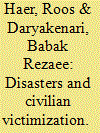

|
|
|
|
|
| Summary/Abstract |
How do natural disasters affect the treatment of civilians by non-state actors? On the one hand, conflict literature argues that adverse shocks influence the strategic interplay between rebel groups and the government, potentially increasing the level of violence against civilians. On the other hand, sociological research on natural disasters argues that they increase social integration and cooperation and are thus expected to reduce the risk of violent behaviour. In this study, we contend that the dynamics of violence against civilians are different in the short term and long term after a disaster strikes. We argue that natural disasters lead to a decrease in violence against civilians perpetrated by rebel groups in the short run. However, over time this temporary improvement in social integration starts to decline, increasing the level of civilian victimization. To examine this potential temporal dynamic, we combine georeferenced information on one-sided violence (Armed Conflict Location & Event Data; ACLED) and data on disasters (Emergency Event Database; EM-DAT). Our results confirm the expected dynamic effects. This research has important implications for our understanding of how disasters can influence the relationship between civilians, rebel groups, and governments.
|
|
|
|
|
|
|
|
|
|
|
|
|
|
|
|
| 4 |
ID:
134150
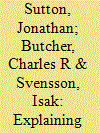

|
|
|
|
|
| Publication |
2014.
|
| Summary/Abstract |
The use of violent coercion to repress unarmed protests, such as that seen during the Arab Spring, sometimes backfires on the government - an outcome called 'political jiu-jitsu'. Examining unique global data covering extreme violence used by governments against unarmed protests from 1989 to 2011 (drawn from UCDP) and the Nonviolent and Violent Campaigns and Outcomes (NAVCO) data, this study aims to explain the conditions under which this outcome occurs. This study contributes to both the nonviolent action and one-sided violence literatures by further disaggregating this effect into both domestic and international outcomes, a distinction that has not previously been made in empirical studies. We find evidence that a pre-existing campaign infrastructure increases the likelihood of increased domestic mobilization and security defections after violent repression, but is unrelated to international backlash. Within ongoing NAVCO campaigns we find that parallel media institutions increase the likelihood of increased domestic mobilization and international repercussions after repression, and that this effect holds true for both traditional media and 'new' (i.e. internet-based) media. One of the novel contributions of this study is that we identify an important selection effect in the NAVCO data and the critical role of organizational infrastructure, especially communications infrastructure, in generating preference changes that create the conditions where killing unarmed civilians becomes costly for repressive governments. We conclude with a discussion of the potential implications of this study and avenues for future research.
|
|
|
|
|
|
|
|
|
|
|
|
|
|
|
|
| 5 |
ID:
190152


|
|
|
|
|
| Summary/Abstract |
This research note extends the Bara and Hultman (2020) study on the effectiveness of non-UN peacekeeping missions in terms of curbing one-sided violence (OSV) against civilians. In particular, we employ two novel instruments to address the two-way causality between the number of non-UN peacekeepers and OSV measures. For each panel year, our instruments involve the interaction between the sum of various designated peacekeepers contributed and the inverse distance between the capitals of contributor and conflict countries. As required, the instrument satisfies the necessary inclusion and exclusion (exogeneity) requirements. The instrument-based results establish a robust reduction in government OSV stemming from the number of non-UN peacekeepers deployed. That reduction also holds for propensity-score matching and the inclusion of UN peacekeepers in the same regression. Non-UN peacekeepers did not have a robust influence on rebel OSV.
|
|
|
|
|
|
|
|
|
|
|
|
|
|
|
|
| 6 |
ID:
185489
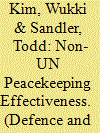

|
|
|
|
|
| Summary/Abstract |
This paper examines the effectiveness of non-UN-led peacekeeping operations (PKOs) from two alternative perspectives. First, the four kinds of regional and international (out of region) PKOs are investigated based on their ability to curtail one-sided violence (OSV) against civilians by host governments or rebels. That analysis is further bolstered by propensity-score matching to ameliorate potential selection bias stemming from non-UN PKOs. For the matched sample, we find that non-UN peacebuilding and peace enforcement missions limit rebel caused OSV, which is a novel result. Second, the ability of non-UN PKOs’ troops and police to end conflict or to maintain peace are ascertained based on survival analysis. Non-UN troops, but not police, curtail the transition from peace, regardless of matching. Generally, non-UN PKOs display effectiveness in limiting OSV or maintaining peace, but not in ending conflict.
|
|
|
|
|
|
|
|
|
|
|
|
|
|
|
|
| 7 |
ID:
157907


|
|
|
|
|
| Summary/Abstract |
Previous research demonstrates that refugee populations can threaten the security of receiving countries. This study, in contrast, seeks to examine the physical security challenges refugees face in host states. It utilizes a new, geographically referenced data set on subcountry refugee demographics to test the hypothesis that locations home to larger refugee populations are more likely to experience one-sided attacks by conflict actors. Results demonstrate that refugee accommodation is a significant predictor of one-sided violence in Africa. In particular, combatants commit significantly more acts of violence against civilians in locations home to larger numbers of self-settled refugees compared to other locations. These findings suggest that scholars and practitioners account for possible dangers presented by refugee flows and threats to refugees simultaneously.
|
|
|
|
|
|
|
|
|
|
|
|
|
|
|
|
| 8 |
ID:
180201
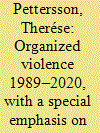

|
|
|
|
|
| Summary/Abstract |
This article reports on trends in organized violence, building on new data by the Uppsala Conflict Data Program (UCDP). The falling trend in fatalities stemming from organized violence in the world, observed for five consecutive years, broke upwards in 2020 and deaths in organized violence seem to have settled on a high plateau. UCDP registered more than 80,100 deaths in organized violence in 2020, compared to 76,300 in 2019. The decrease in violence in Afghanistan and Syria was countered by escalating conflicts in, for example, Artsakh (Nagorno-Karabakh), Azerbaijan and Tigray, Ethiopia. Moreover, the call for a global ceasefire following the outbreak of the COVID-19 pandemic failed to produce any results. In fact, the number of active state-based and non-state conflicts, as well as the number of actors carrying out one-sided violence against civilians, increased when compared to 2019. UCDP noted a record-high number of 56 state-based conflicts in 2020, including eight wars. Most of the conflicts occurred in Africa, as the region registered 30 state-based conflicts, including nine new or restarted ones.
|
|
|
|
|
|
|
|
|
|
|
|
|
|
|
|
| 9 |
ID:
147839
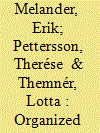

|
|
|
|
|
| Summary/Abstract |
The alarming upward trend since 2012 in the number of fatalities incurred by organized violence did not continue in 2015. Indeed, 2014 saw more than 130,000 people killed in organized violence while in 2015 this figure was close to 118,000. This is still an unusually high number, the third-worst year in the post-Cold War period. The number of conflicts continued to increase from 41 in 2014 to 50 in 2015. This increase was by and large driven by the expansion of the Islamic State. Most of the fatalities, over 97,000, incurred in state-based conflicts. Non-state conflicts also increased, from 61 in 2014 to 70 in 2015, the highest number recorded in the 1989–2015 period. No non-state conflict passed the threshold of 1,000 battle-related deaths, but 11 state-based conflicts did – a decrease by one from 2014. Seven of the ten most violent state-based conflicts in 2014 became less violent. Twenty-six actors were registered in one-sided violence just as in 2014, while the number of fatalities decreased from over 13,500 to 9,500.
|
|
|
|
|
|
|
|
|
|
|
|
|
|
|
|
| 10 |
ID:
154850
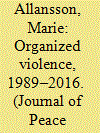

|
|
|
|
|
| Summary/Abstract |
The dramatic increase in the number of fatalities in organized violence, seen between 2011 and 2014, did not continue in 2015 and 2016. Rather, the notation of some 131,000 fatalities in 2014 was followed by a steep decline, with just below 119,000 in 2015 and a little over 102,000 fatalities in 2016. Despite the decrease, the number was the fifth highest during the entire 1989–2016 period. Most of the fatalities – over 87,000 – were incurred in state-based conflicts, the main driver behind the trend. Just as the number of fatalities, the number of state-based conflicts, albeit remaining on a high level, continued to decrease in 2016, going from 52 to 49, with 12 of them reaching the level of war, with at least 1,000 battle-related deaths. Also the non-state conflicts dropped in number in 2016, from 73 to 60. This was followed by a decrease in the number of fatalities, and only one conflict caused more than 1,000 deaths. Twenty-one actors were registered in one-sided violence, down by five from 2015. A number this low has only been recorded twice before; in both 2009 and 2010, 21 one-sided actors were listed in UCDP data. The number of fatalities also decreased, going from almost 9,800 to a little over 6,000.
|
|
|
|
|
|
|
|
|
|
|
|
|
|
|
|
| 11 |
ID:
167284
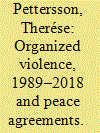

|
|
|
|
|
| Summary/Abstract |
This article reports on trends in organized violence and peace agreements collected by the Uppsala Conflict Data Program (UCDP). The number of fatalities in organized violence decreased for the fourth consecutive year, to reach the lowest level since 2012. In 2018, UCDP recorded almost 76,000 deaths: a decrease of 20% compared to 2017, and 43% compared to the latest peak in 2014. State-based armed conflict drives this downward trend in organized violence, with Syria accounting for much of the change. The number of civilians killed in one-sided violence also dropped in 2018, reaching its lowest level since 2012. In contrast, non-state conflict remained on a high level. The general decline in fatalities from organized violence does not correspond with the trend in the number of active conflicts. In fact, the world has seen a new peak in the number of conflicts after 2014, matched only by the number of conflicts in the early 1990s. In 1991, the peak in the number of armed conflicts corresponded with a similar peak in the number of signed peace agreements. This was followed by a decrease in the number of conflicts in the late 1990s and early 2000s. However, the most recent rise in armed conflicts has not been matched by a similar rise in the number of peace agreements. Two circumstances that characterize the recent rise in conflicts have also been found to make conflicts harder to solve: explicit religious claims and high levels of internationalization.
|
|
|
|
|
|
|
|
|
|
|
|
|
|
|
|
|
|
|
|
|